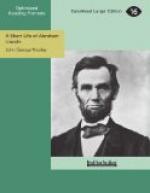If Lincoln’s muscles were at times hungry for work, not less so was his mind. He was already instinctively feeling his way to his destiny when, in conversation with Mentor Graham, the schoolmaster, he indicated his desire to use some of his spare moments to increase his education, and confided to him his “notion to study English grammar.” It was entirely in the nature of things that Graham should encourage this mental craving, and tell him: “If you expect to go before the public in any capacity, I think it the best thing you can do.” Lincoln said that if he had a grammar he would begin at once. Graham was obliged to confess that there was no such book at New Salem, but remembered that there was one at Vaner’s, six miles away. Promptly after breakfast the next morning Lincoln walked to Vaner’s and procured the precious volume, and, probably with Graham’s occasional help, found no great difficulty in mastering its contents. While tradition does not mention any other study begun at that time, we may fairly infer that, slight as may have been Graham’s education, he must have had other books from which, together with his friendly advice, Lincoln’s intellectual hunger derived further stimulus and nourishment.
In his duties at the store and his work at the mill, in his study of Kirkham’s “Grammar,” and educational conversations with Mentor Graham, in the somewhat rude but frank and hearty companionship of the citizens of New Salem and the exuberant boys of Clary’s Grove, Lincoln’s life for the second half of the year 1831 appears not to have been eventful, but was doubtless more comfortable and as interesting as had been his flatboat building and New Orleans voyage during the first half. He was busy in useful labor, and, though he had few chances to pick up scraps of schooling, was beginning to read deeply in that book of human nature, the profound knowledge of which rendered him such immense service in after years.
The restlessness and ambition of the village of New Salem was many times multiplied in the restlessness and ambition of Springfield, fifteen or twenty miles away, which, located approximately near the geographical center of Illinois, was already beginning to crave, if not yet to feel, its future destiny as the capital of the State. In November of the same year that aspiring town produced the first number of its weekly newspaper, the “Sangamo Journal,” and in its columns we begin to find recorded historical data. Situated in a region of alternating spaces of prairie and forest, of attractive natural scenery and rich soil, it was nevertheless at a great disadvantage in the means of commercial transportation. Lying sixty miles from Beardstown, the nearest landing on the Illinois River, the peculiarities of soil, climate, and primitive roads rendered travel and land carriage extremely difficult—often entirely impossible—for nearly half of every year. The very first number of the “Sangamo Journal” sounded its strongest




